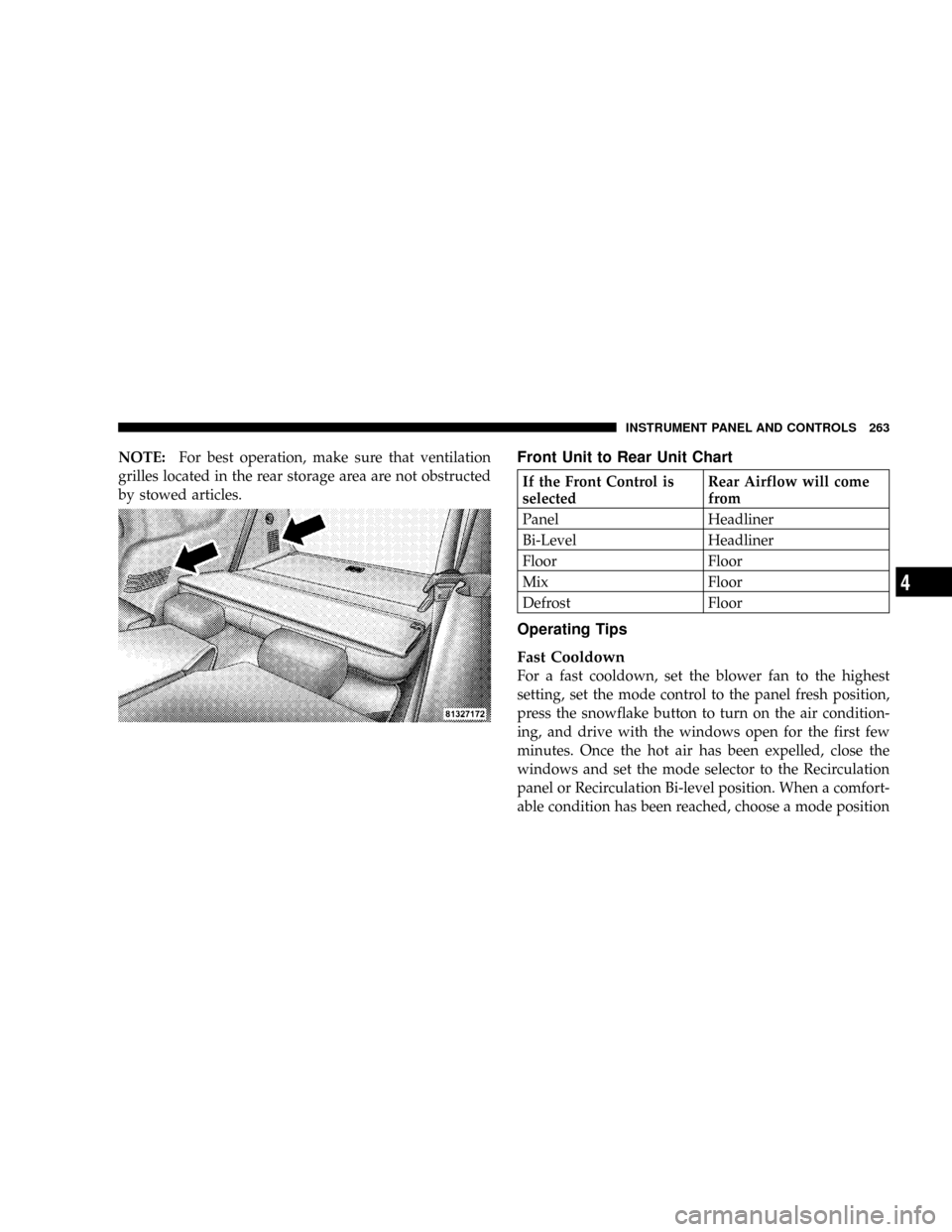DODGE DURANGO 2008 2.G Owners Manual
Manufacturer: DODGE, Model Year: 2008, Model line: DURANGO, Model: DODGE DURANGO 2008 2.GPages: 481, PDF Size: 7.75 MB
Page 261 of 481

REAR OFF
This turns the rear system off. The control will return to
the front system display after approximately 5 seconds if
no buttons are pushed while in one of the rear system
displays. You may also return to the front system display
sooner by pushing any button except the POWER/FAN
knob, the rear button, the driver/passenger temp rocker
buttons.
NOTE:The display will show ªREAR OFF.º
REAR AUTO
This mode places the rear system in automatic tempera-
ture control. Rear temperature can be set as desired (72
recommended for average person) and will be displayed
digitally on the front control when in rear mode.
Rear Window Defrosting and Rear Window
Washer/Wiper
See the ªRear Window Featuresº section of this book.
Rear Zone Climate Control Ð If Equipped
Headliner air comes from the outlets in the headliner.
Each of these outlets can be individually adjusted to
direct the flow of air. Moving the air vane knobs on the
outlets to one side will shut off the airflow.
INSTRUMENT PANEL AND CONTROLS 261
4
Page 262 of 481

The rear compartment control uses two rotary knobs: one
for the temperature control and the other for the fan
speed control. The mode for the rear air conditioning and
heating system is always controlled by the front control
unit. Fan and temperature can be controlled from the
front control unit or the rear control unit.
Rear Rotary Blower Control
The second row seat occupants have control of the rear
blower speed, only when the front control unit is in the
ªREAR CONTROLº position or CONTROL IN REAR9
for ATC.9
The rear blower switch has an ªOffº position and a range
of blower speeds. Rotating the rear blower control clock-
wise will increase the blower speed.
Rear Rotary Temperature Control
The second row seat occupants have contorl of the rear
temperature only when the front control unit is in the
9REAR CONTROL9position.
To change the temperature in the rear of the vehicle,
rotate the temperature control knob to the right or left.
The blue area indicates cooler temperatures while the red
area indicates warmer temperatures.
262 INSTRUMENT PANEL AND CONTROLS
Page 263 of 481

NOTE:For best operation, make sure that ventilation
grilles located in the rear storage area are not obstructed
by stowed articles.Front Unit to Rear Unit Chart
If the Front Control is
selectedRear Airflow will come
from
Panel Headliner
Bi-Level Headliner
Floor Floor
Mix Floor
Defrost Floor
Operating Tips
Fast Cooldown
For a fast cooldown, set the blower fan to the highest
setting, set the mode control to the panel fresh position,
press the snowflake button to turn on the air condition-
ing, and drive with the windows open for the first few
minutes. Once the hot air has been expelled, close the
windows and set the mode selector to the Recirculation
panel or Recirculation Bi-level position. When a comfort-
able condition has been reached, choose a mode position
INSTRUMENT PANEL AND CONTROLS 263
4
Page 264 of 481

and adjust the temperature control and blower speed as
necessary to maintain comfort. For high humidity condi-
tions it may be necessary to remain in the Recirculation
mode to maintain comfort.
Window Fogging
Windows will fog on the inside when the humidity inside
the vehicle is high. This often occurs in mild or cool
temperatures when it's rainy or humid. In most cases
turning on the Air-conditioning (pressing the snowflake
button) will clear the fog. Adjust the temperature control,
air direction and blower speed to maintain comfort.
As the temperature gets colder it may be necessary to
direct air onto the windshield by using MIX Mode
position on the control. Adjust the temperature control
and blower speed to maintain comfort. Interior fogging
on the windshield can be quickly removed by selecting
the defrost mode.Regular cleaning of the inside of the windows with a
non-filming cleaning solution (vinegar and water works
very well) will help prevent contaminates (cigarette
smoke, perfumes, etc.) from sticking to the windows.
Contaminates increase the rate of window fogging.Summer Operation
Air conditioned vehicles must be protected with a high
quality antifreeze coolant during summer to provide
proper corrosion protection and to raise the boiling point
of the coolant for protection against overheating. A 50 %
concentration is recommended.
Winter Operation
When operating the system during the winter months,
make sure the air intake, located directly in front of the
windshield, is free of ice, slush, snow, or other obstruc-
tions. This will also prevent snow ingestion into the
ducts.
264 INSTRUMENT PANEL AND CONTROLS
Page 265 of 481

Operating Tips Chart
INSTRUMENT PANEL AND CONTROLS 265
4
Page 266 of 481

REAR WINDOW FEATURES
Rear Window Wiper/Washer
A rotating switch located on the climate control
panel turns the rear wiper On or Off. Pressing the
rotating switch inward activates the rear window
washer. Rotating the switch will enable one of five
intermittent delay times for the rear wiper. The delay
times range from 20 to 1 second.
266 INSTRUMENT PANEL AND CONTROLS
Page 267 of 481

If the rear wiper is operating when the ignition is turned
off, the wiper will automatically return to the ªParkº
position. When the vehicle is restarted, the wiper will
resume operation.
Rear Window Defrosting
A push-button type switch is located in the climate
control panel. Press the switch and the rear win-
dow defroster and electric remote control heated mirrors
(if equipped) will turn On. An amber indicator on the
push-button will light when the defroster is turned On.
An symbol will be displayed when the defroster is turned
on with an ATC control. Push again to turn Off prior to
time-out. The defroster will automatically turn Off after
fifteen minutes. For ten more minutes of operation, push
the button again. To prevent excessive battery drain, use
the defroster only when the engine is operating.
CAUTION!
Use care when washing the inside of the rear window
to prevent damage to heating elements. Use a soft
cloth and a mild washing solution, wiping parallel to
the heating elements. Also, keep all objects a safe
distance from the window to prevent damaging the
heating elements.
INSTRUMENT PANEL AND CONTROLS 267
4
Page 268 of 481

Page 269 of 481

STARTING AND OPERATING
CONTENTS
mStarting Procedures.....................273
NAutomatic Transmission................273
NNormal Starting......................273
mEngine Block Heater ± If Equipped..........276
mAutomatic Transmission..................276
NAutomatic Transmission................276
mFour-Wheel Drive Operation...............281
NNV 140 Transfer Case Operating
Information/Precautions ± If Equipped......281NNV 244 Generation II Transfer Case Operating
Information / Precautions...............282
NShifting Procedure - NV 244 Generation II
Transfer Case........................286
mDriving On Slippery Surfaces..............287
mDriving Through Water..................288
NFlowing/Rising Water..................288
NShallow Standing Water.................288
mParking Brake.........................290
5
Page 270 of 481

mBrake System..........................291
NFour-Wheel Anti-Lock Brake System (ABS) . . . 291
mPower Steering........................294
mElectronic Brake Control System............295
NABS (Anti-Lock Brake System)............295
NBAS (Brake Assist System)...............296
NTCS (Traction Control System)............298
NERM (Electronic Roll Mitigation)..........298
NESP (Electronic Stability Program).........299
mMulti Displacement System (MDS) Ð 5.7L
Engine Only..........................304
mTire Safety Information...................305
NTire Markings........................305NTire Identification Number (TIN)..........308
NTire Loading And Tire Pressure...........309
mTires Ð General Information...............313
NTire Pressure.........................313
NTire Inflation Pressures.................314
NRadial-Ply Tires......................316
NCompact Spare Tire Ð If Equipped.........317
NLimited Use Spare Ð If Equipped.........317
NTire Spinning........................318
NTread Wear Indicators..................319
NLife Of Tire.........................319
NReplacement Tires.....................320
NAlignment And Balance.................321
270 STARTING AND OPERATING